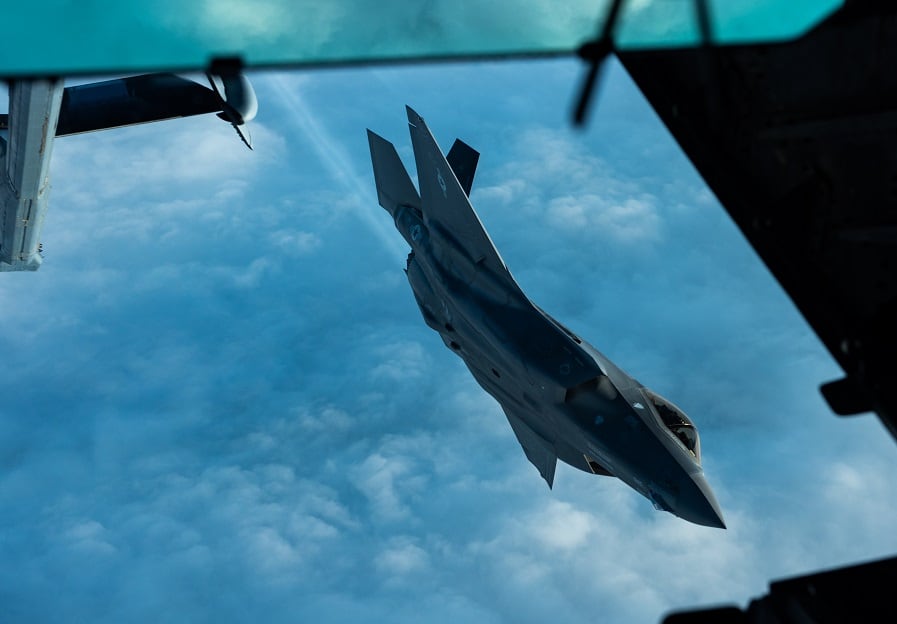WASHINGTON — The U.S. Navy wants more from the F-35 jet’s radar, which in sea-search mode is limited to what is directly in front of the aircraft, according to documents exclusively obtained by Defense News.
According to the documents, the radar, Northrop Grumman’s AN/APG-81 active electronically scanned array radar, can either hone in on a sector based on a specific point on the ground, or work in what is commonly known as “snowplow mode,” which, as the name suggests, searches everything in front of the aircraft.
The Navy wants to be able to scan a wider area when in sea-search mode, something that the radar is currently not set up for, according to officials who spoke to Defense News.
Officials also said the problem is on track for a solution, but may not be implemented until as late as 2024 with the Block 4 upgrades, notably adding that a solution will not be in place before a full-rate production decision on the F-35 this year.
Ultimately, giving the Navy what it wants will be a matter of boosting computing power and upgrading software, officials explained.
The issue is listed as a category 1 deficiency, according to the documents, which further define the limitation as something that means “adequate performance [is] not attainable to accomplish the primary or alternate mission(s).” The issue dates back to 2012, according to the documents. In this scale, category 1 represents the most serious type of deficiency.
It’s unclear why the issue is listed as a deficiency. The system is working in accordance with design specifications, according to both the documents and a statement from a Lockheed Martin executive.
“The F-35’s current radar sea search function meets the enterprises’ expressed required specification," said Greg Ulmer, Lockheed Martin’s general manager of the company’s F-35 program. “As we modernize the F-35, we are bringing enhanced search capabilities, which represent an increase from the original requirements, and we stand ready to integrate the upgrade in the future, based on customer priorities and direction.”
Click here for more on the hidden troubles of the F-35.
In an interview with Defense News, the head of the Pentagon’s F-35 program office, Vice Adm. Mat Winter, said the issue was being resolved by software and computing upgrades, and there would be no requirement for a new radar.
RELATED

“We’re not mechanically scanning, we’re electronically scanning,” Winter said. “And being able to accurately scan the maritime environment, it just takes increased computing power, and that’s what we’re doing. … It’s a software fix, and then an allocation of computing power.”
Winter may be referring to a planned bundle of computer upgrades called Tech Refresh 3, where the jet will get more modern computing systems that will increase the jet’s processing power and memory. According to one document obtained by Defense News, TR3 is a prerequisite for a future radar fix. Those TR3-equipped jets won’t roll off the production line until 2023.
Defense News submitted written questions to the Defense Department’s F-35 program office concerning these and other deficiencies, but it did not respond by press time, despite multiple follow-ups over a period of months.
A retired fighter pilot, who reviewed the documents for Defense News and agreed to speak on condition of anonymity, agreed with Winter’s assessment that the fix was likely software-based.
Early on in the F/A-18’s APG-79 AESA radar, there were glitches in the operation, but software updates smoothed out the system. Fixing the APG-81 should follow a similar track as the aircraft progresses, the pilot explained.
“As long as the array itself is technically sound, I suspect over time they’ll be able to find ways to continue to build out capability through software updates,” the retired fighter pilot said.
Valerie Insinna in Washington contributed to this report.
David B. Larter was the naval warfare reporter for Defense News.
Valerie Insinna is Defense News' air warfare reporter. She previously worked the Navy/congressional beats for Defense Daily, which followed almost three years as a staff writer for National Defense Magazine. Prior to that, she worked as an editorial assistant for the Tokyo Shimbun’s Washington bureau.








